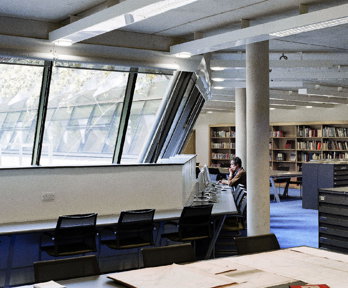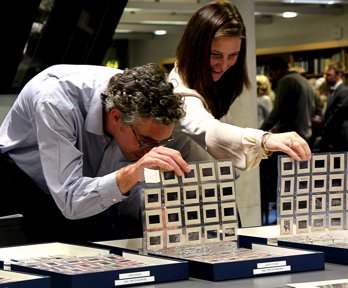
About our Collections
Our Collections contain over two million documents, maps, photographs, paintings, periodicals, artefacts and books, and span 500 years of geography, travel and exploration.
Our Collections are generously supported by the Heritage Lottery Fund and others, and we:
-
Preserve the Collections for the benefit of future generations
-
Provide public access to our materials
-
Promote Collections-related educational resources and events for schools and life-long learners
We have been awarded Designated Status for our Collections in their entirety by the Museums, Libraries and Archives Council. This scheme aims to identify and celebrate the pre-eminent collections of national and international importance held in England’s non-national museums, libraries and archives.
Our Collections, associated exhibitions and the curatorial work of the Picture Library are supported by Rolex.
Ìý
Artefacts
OurÌýartefacts collection includes over a thousand items brought to the Society, consisting mainly of three item types:
-
Cultural objects from around the world. These range from Inuit boots from Canadian Arctic to ceremonial leopard’s claws from the then Belgian Congo
-
Paraphernalia of exploration, for example,Ìýoxygen sets used in theÌývariousÌýattempts on Everest
-
Personal items formerly belonging to some of the world’s greatest explorers, such as Shackleton’s Burberry helmet
Our artefacts have been loaned to exhibitions around the world and are in continual demand so it is not always possible to see them. However,Ìýyou can usually findÌýan image of the artefact in the Picture Library collection. The Society has also created replicas of regularly requested items, including Stanley’s pith helmet and Scott’s food bags.
It is always advisable to book in advanceÌýto see our artefacts for as when not on loan,Ìýour artefacts are housed in temperature- and humidity-controlled secure stores.
Ìý
Books and pamphlets
Our library collection holds over 150,000 bound volumes dating primarily from the foundation of the Society in 1830 onwards. Their primary focus is on the history and geography of places worldwide including:
-
Information on European migration
-
AÌýwork charting changes in theÌýice shelvesÌýof Antarctica
-
AÌý19th century guidebook to Berlin
-
David Livingstone’s account of his search for the source of the Nile
-
AÌýtitle discussing water resource management issues
-
AÌýdescription of the Yangtze's Three Gorges
Ìý
Maps and atlases
We hold one of the largest private map collections in the world and it is continuously increasing in size. It includesÌýone million sheets of maps and charts, 3000 atlases, 40 globes (as gores or mounted on stands) and 1000 gazetteers. Our earliest printed cartographic item dates back to 1485.
The map collection has a focus on scientifically surveyed maps and charts from official agencies at home and abroad.Ìý It also includes original manuscript mapping.
Ìý
Manuscripts
Our manuscript collection consists of material arising out of the conduct of Society business and manuscripts relating to people or subjects of special interest. The collection also includes a few papers from before the Society's foundation in 1830. While individual special collections may not be fully comprehensive, they do complement those in other establishments.
The manuscript collection is particularly useful to:
-
Biographers of nineteenth and early twentieth century travellers and geographers
-
Researchers interested in the development of geographical knowledge and the historical development of geography
Ìý
Photographs and artworks
Our Picture Library holds over half a million photographs, artworks, negatives, lantern slides and albums dating from around 1830. We offer a rich source of imagery, fromÌýa golden age of travel and exploration, to modern geographical depictions.
Historic images range from the great Antarctic adventures of Scott and Shackleton to the pioneering journeys of Livingstone, Baker, Speke and Burton.
Within the Society’s Photographic Collection there are some historical images (and image titles or captions) which are recognised as containing unacceptable forms of language, or present image content that is considered inappropriate. In such cases, as part of its Collections policy, the Society maintains access to those images and descriptors as a source of context and information for researchers, recognising that the historical language used or image subjects in themselves do not reflect the Society’s contemporary position as an organisation wholly committed to principles of equality and diversity.
Ìý
Journals
While we currently receive around 800 journal titles, our journals collection contains many more titles, including some that are either no longer subscribed to, or have ceased publication.
We also publishes a number of journals.
Ìý
Expedition reports
We house a unique collection of over 4,500Ìýexpedition reports. TheseÌýdocuments contain details of the achievements and research results of expeditions to almost every country of the world and provide information on a wide variety of sporting, scientific and youth expeditions from 1965 to the present day.
The catalogue of these reports, and over 8,500 planned and past expeditions,Ìýis held on the Expeditions Database.
Ìý
Films
The Society’s 100+ films, housed at the British Film Institute, represent a unique record of British scientific exploration and geographical documentary film-making over a period of 57 years (1922 -1979).
The collection is unique to the Society and includes a mix of amateur and professional film, often created by the Society’s Fellows or those involved in projects supported by the Society. Digitising the Society’s film collection has ensured its protection and security for the future.
Individual films in the collection show peoples and places from around the world and provide a valuable record of lost or vanishing cultures, and geographical locations undergoing significant change. Other films link to the Society’s wider Collection, and to its role supporting field expeditions.
The film collection also includes material which is of specific relevance to black and minority ethnic (BME) communities. The Society has developed a successful programme of public engagement specifically with BME community groups and individuals, and the film collection enhances existing relationships and enables new community engagement activities to be undertaken.
The Society’s film collection has now been fully digitised as part of a Heritage Lottery Project: ‘Unlocking Britain’s Film Heritage’ and is freely available for research and enjoyment via the BFI Player.
Ìý
If you have information regarding any of the films please email film@rgs.org
For all commercial enquiries relating to the film archive please contact footagefilms@bfi.org.uk

Visit the Foyle Reading Room
Plan a visit to the Foyle Reading Room to consult and research items in our Collections.

Wiley Digital Archive
A digitisation project enabling hundreds of thousands of items from our Collections to be digitised, allowing access to wider audiences in order to support teaching and learning.
